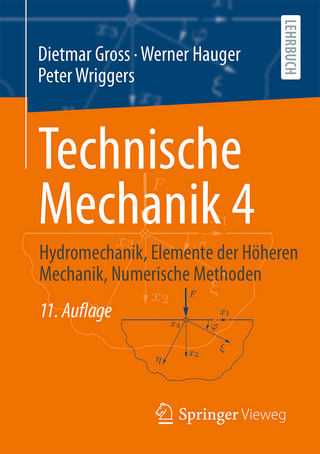
Nonlinear Continuum Mechanics
Springer International Publishing (Verlag)
978-3-031-15209-2 (ISBN)
This textbook on Continuum Mechanics presents 9 chapters. Chapters 1 and 2 are devoted to Tensor Algebra and Tensor Analysis. Part I of the book includes the next 3 chapters. All the content here is valid for both solid and fluid materials. At the end of Part I, the reader should be able to set up in local spatial/material form, the fundamental governing equations and inequalities for a Continuum Mechanics problem. Part II of the book, Chapters 6 to 10, is devoted to presenting some nonlinear constitutive models for Nonlinear Solid Mechanics, including Finite Deformation Hyperelasticity, Finite Deformation Plasticity, Finite Deformation Coupled Thermoplasticity, and Finite Deformation Contact Mechanics. The constitutive equations are derived within a thermodynamically consistent framework. Finite deformation elastoplasticity models are based on a multiplicative decomposition of the deformation gradient and the notion of an intermediate configuration. Different formulations based on the intermediate configuration, the current or spatial configuration, and the material configuration are considered. The last chapter is devoted to Variational Methods in Solid Mechanics, a fundamental topic in Computational Mechanics. The book may be used as a textbook for an advanced Master's course on Nonlinear Continuum Mechanics for graduate students in Civil, Mechanical or Aerospace Engineering, Applied Mathematics, or Applied Physics, with an interest in Continuum Mechanics and Computational Mechanics.
Carlos Agelet de Saracibar is Full Professor of Continuum Mechanics and Structural Analysis at the Escuela Técnica Superior de Ingenieros de Caminos, Canales y Puertos, UPC BarcelonaTech. He is also Head of the Specific Research Center Computational Continuum Mechanics (MC)2-UPC. He has participated in several funded European, national, and regional research projects, mainly related to the application of the finite element method (FEM) to computational modeling and numerical simulation of coupled thermo-mechanical problems, in particular to the numerical simulation of industrial metal forming processes, such as sheet metal forming (SMF), casting and solidification (gravity casting, low-pressure die casting, high-pressure die casting, lost foam casting), laser heat forming (LHF), shaped metal deposition (SMD), welding, friction stir welding (FSW), and additive manufacturing (AM) processes.
Chapter 1: Tensor Algebra.- Chapter 2: Tensor Analysis.- Chapter3: Kinematics.- Chapter 4: Stresses.- Chapter 5: Balance Principles.- Chapter 6: Finite Deformation Hyperelasticity.- Chapter 7: Finite Deformation Plasticity.- Chapter 8: Finite Deformation Coupled Thermoplasticity.- Chapter 9: Finite Deformation Contact Mechanics.- Chapter 10: Variational Methods.
| Erscheinungsdatum | 30.08.2024 |
|---|---|
| Zusatzinfo | XX, 344 p. 43 illus., 42 illus. in color. |
| Verlagsort | Cham |
| Sprache | englisch |
| Maße | 155 x 235 mm |
| Gewicht | 618 g |
| Themenwelt | Naturwissenschaften ► Physik / Astronomie ► Mechanik |
| Technik ► Maschinenbau | |
| Schlagworte | Contact Mechanics • Continuum Mechanics • Coupled Thermomechanical Problems • finite deformation • Finite Strain Elasticity • Finite Strain Plasticity • Hyperelasticity • Plasticity • Thermoplasticity • variational methods |
| ISBN-10 | 3-031-15209-3 / 3031152093 |
| ISBN-13 | 978-3-031-15209-2 / 9783031152092 |
| Zustand | Neuware |
| Informationen gemäß Produktsicherheitsverordnung (GPSR) | |
| Haben Sie eine Frage zum Produkt? |
aus dem Bereich


